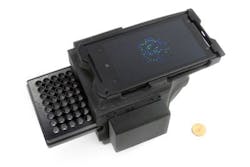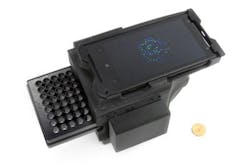Smartphone method makes DNA biomarker detection portable and low-cost
Leveraging the sensors and optics in smartphones, researchers at the University of California, Los Angeles (UCLA) have developed a method to detect the presence of DNA biomarkers of disease that is compatible with use outside of a hospital or lab setting. The smartphone reads light produced by a new detector dye mixture that reports the presence of DNA molecules with a signal that is more than 10X brighter.
Related: Machine learning enhances smartphone attachment for disease detection
Nucleic acids, such as DNA or RNA, are used in tests for infectious diseases, genetic disorders, cancer mutations that can be targeted by specific drugs, and fetal abnormality tests. The samples used in standard diagnostic tests typically contain only tiny amounts of a disease's related nucleic acids. To assist optical detection, clinicians amplify the number of nucleic acids, making them easier to find with the fluorescent dyes.
Both the amplification and optical detection steps have in the past required costly and bulky equipment, largely limiting their use to laboratories. Recognizing this, the research team focused on these challenges with low-cost optical detection. Small changes in light emitted from molecules that associate with DNA, called intercalator dyes, are used to identify DNA amplification, but these dyes are unstable and their changes are too dim for standard cellphone camera sensors.
So, the team discovered an additive that stabilized the intercalator dyes and generated a large increase in fluorescent signal above the background light level, enabling the test to be integrated with inexpensive smartphone-based detection methods. The combined novel dye/cellphone reader system achieved comparable results to equipment costing tens of thousands of dollars more.
To adapt a smartphone to detect the light produced from dyes associated with amplified DNA while those samples are in standard laboratory containers, such as well plates, the team developed a cost-effective, field-portable fiber-optic bundle. The fibers in the bundle routed the signal from each well in the plate to a unique location of the camera sensor area. This handheld reader is able to provide comparable results to standard benchtop readers, but at a fraction of the cost, which the authors suggest is a promising sign that the reader could be applied to other fluorescence-based diagnostic tests.
"Currently, nucleic acid amplification tests have issues generating a stable and high signal, which often necessitates the use of calibration dyes and samples which can be limiting for point-of-care use," says Dino Di Carlo, professor of bioengineering and mechanical and aerospace engineering. "The unique dye combination overcomes these issues and is able to generate a thermally stable signal, with a much higher signal-to-noise ratio. The DNA amplification curves we see look beautiful—without any of the normalization and calibration, which is usually performed, to get to the point that we start at."
Additionally, the authors emphasized that the dye combinations discovered should be able to be used universally to detect any nucleic acid amplification, allowing for their use in a multitude of other amplification approaches and tests.
The team demonstrated the approach using a process called loop-mediated isothermal amplification (LAMP) with DNA from lambda phage as the target molecule, as a proof of concept, and now plan to adapt the assay to complex clinical samples and nucleic acids associated with pathogens such as influenza.
Full details of the work appear in the journal ACS Nano; for more information, please visit http://dx.doi.org/10.1021/acsnano.6b08274.

